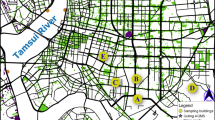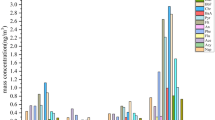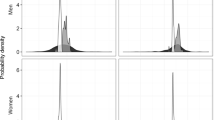Abstract
Currently in the United States there are no regulatory standards for ambient concentrations of polycyclic aromatic hydrocarbons (PAHs), a class of organic compounds with known carcinogenic species. As such, monitoring data are not routinely collected resulting in limited exposure mapping and epidemiologic studies. This work develops the log-mass fraction (LMF) Bayesian maximum entropy (BME) geostatistical prediction method used to predict the concentration of nine particle-bound PAHs across the US state of North Carolina. The LMF method develops a relationship between a relatively small number of collocated PAH and fine Particulate Matter (PM2.5) samples collected in 2005 and applies that relationship to a larger number of locations where PM2.5 is routinely monitored to more broadly estimate PAH concentrations across the state. Cross validation and mapping results indicate that by incorporating both PAH and PM2.5 data, the LMF BME method reduces mean squared error by 28.4% and produces more realistic spatial gradients compared to the traditional kriging approach based solely on observed PAH data. The LMF BME method efficiently creates PAH predictions in a PAH data sparse and PM2.5 data rich setting, opening the door for more expansive epidemiologic exposure assessments of ambient PAH.
This is a preview of subscription content, access via your institution
Access options
Subscribe to this journal
Receive 6 print issues and online access
$259.00 per year
only $43.17 per issue
Buy this article
- Purchase on Springer Link
- Instant access to full article PDF
Prices may be subject to local taxes which are calculated during checkout



Similar content being viewed by others
References
Di-Toro DM, McGrath JA, Hansen DJ. Technical basis for narcotic chemicals and polycyclic aromatic hydrocarbon criteria.I. Water and tissue. Environ Toxicol Chem. 2000;19:1951–70.
Zhang Y, Tao S. Global atmospheric emission inventory of polycyclic aromatic hydrocarbons (PAHs) for 2004. Atmos Environ. 2009;43:812–9.
Bocskay KA, Tang D, Orjuela MA, Liu X, Warburton DP, Perera FP. Chromosomal aberrations in cord blood are associated with prenatal exposure to carcinogenic polycyclic aromatic hydrocarbons. Caner Epidemiol Biomark Prev. 2005;14:506–11.
Wolff MS, Teitelbaum SL, Lioy PJ, Santella RM, Wang RY, Jones RL, et al. Exposures among pregnant women near the World Trade Center Site on 11 September 2001. Environ Health Perspect. 2005;113:739–48.
Menzie CA, Potocki BB, Santodonato J. Exposure to carinogenic PAHs in the environment. Environ Sci Technol. 1992;26:1278–84.
EPA U. Polycyclic aromatic hydrocarbons (PAHs) — EPA fact sheet. 2013 https://www.epa.gov/sites/production/files/2014-03/documents/pahs_factsheet_cdc_2013.pdf.
Kim K-H, Jahan SA, Kabir E, Brown RJC. A review of airborne polycyclic aromatic hydrocarbons (PAHs) and their human health effects. Environ Int. 2013;60:71–80.
Ravindra K, Sokhi R, van Grieken R. Atmospheric polycyclic aromatic hydrocarbons: source attribution, emission factors and regulation. Atmos Environ. 2008;42:2895–921.
Pleil JD, Vette AF, Rappaport SM. Assaying particle-bound polycyclic aromatic hydrocarbons from archived PM2.5 filters. J Chromatogr A. 2004;1033:9–17.
Abdel-Shafy HI, Mansour MSM. A review on polycyclic aromatic hydrocarbons: source, environmental impact, effect on human health and remediation. Egypt J Pet. 2015;25:107–23.
Augusto S, Máguas C, Matos J, Pereira MJ, Soares A, Branquinho C. Spatial modeling of PAHs in lichens for fingerprinting of multisource atmospheric pollution. Environ Sci Technol. 2009;43:7762–9.
Ribeiro MC, Pinho P, Llop E, Branquinho C, Pereira MJ. Geostatistical uncertainty of assessing air quality using high-spatial-resolution lichen data: a health study in the urban area of Sines, Portugal. Sci Total Environ. 2015;562:740–50.
Allshouse WB, Pleil JD, Rappaport SM, Serre ML. Mass fraction spatiotemporal geostatistics and its application to map atmospheric polycyclic aromatic hydrocarbons after 9/11. Stoch Environ Res Risk Assess. 2009;23:1213–23.
Lee C-L, Huang H-C, Wang C-C, Sheu C-C, Wu C-C, Leung S-Y, et al. A new grid-scale model simulating the spatiotemporal distribution of PM2.5-PAHs for exposure assessment. J Hazard Mater. 2016;314:286–94.
Guerreiro CBB, Horálek J, de Leeuw F, Couvidat F. Benzo(a)pyrene in Europe: ambient air concentrations, population exposure and health effects. Environ Pollut. 2016;214:657–67.
Zhang J, Wang P, Li J, Mendola P, Sherman S, Ying Q. Estimating population exposure to ambient polycyclic aromatic hydrocarbon in the United States - Part II: Source apportionment and cancer risk assessment. Environ Int. 2017;99:263–74.
US EPA. Air Quality System (AQS). 2011. http://www.epa.gov/ttn/airs/airsaqs/ (Accessed 11 Sep 2010).
Liu B, Xue Z, Zhu X, Jia C. Long-term trends (1990–2014), health risks, and sources of atmospheric polycyclic aromatic hydrocarbons (PAHs) in the U.S. Environ Pollut. 2017;220:1171–9.
Christakos G. Modern spatiotemporal geostatistics. New York, NY: Oxford University Press; 2000.
Christakos G, Serre ML, Kovitz JL. BME representation of particulate matter distributions in the state of California on the basis of uncertain measurements. J Geophys Res. 2001;106:9717–31.
Serre ML, Christakos G. Modern geostatistics: computational BME analysis in the light of uncertain physical knowledge - the Equus Beds study. Stoch Environ Res Risk Assess. 1999;13:1–26.
Christakos G, Bogaert P, Serre ML. Temporal GIS: Advanced functions for field-based applications. New York, NY: Springer; 2002.
Berntsen J, Espelid TO, Genz A. An adaptive algorithm for the approximate calculation of multiple integrals. ACM Trans Math Softw. 1991;17:437–51.
Genz A. Statistics applications of subregion adaptive multiple numerical integration. In: Espelid T.O., Genz A. (eds) Numerical Integration. NATO ASI Series (Series C: Mathematical and Physical Sciences), Netherlands: Springer. 1992;357:267–80.
United States Geological Survey. Federal Wildland Fire Occurrence Data. 2016. http://wildfire.cr.usgs.gov/firehistory/data.html.
Fuentes M, Raftery AE. Model evaluation and spatial interpolation by Bayesian combination of observations with outputs from numerical models. Biometrics. 2005;61:36–45.
Xu Y, Serre ML, Reyes JM, Vizuete W. Bayesian Maximum Entropy integration of ozone observations and model predictions: A national application. Environ Sci Technol. 2016;50:4393–400.
Liu LY, Kukucka P, Venier M, Salamova A, Klanova J, Hites RA. Differences in spatiotemporal variations of atmospheric PAH levels between North America and Europe: data from two air monitoring projects. Environ Int. 2013;64:48–55.
Jedynska A, Hoek G, Wang M, Eeftens M, Cyrys J, Keuken M, et al. Development of land use regression models for elemental, organic carbon, PAH, and hopanes/steranes in 10 ESCAPE/TRANSPHORM European study areas. Environ Sci Technol. 2014;48:14435–44.
Noth EM, Hammond SK, Biging GS, Tager IB. A spatial-temporal regression model to predict daily outdoor residential PAH concentrations in an epidemiologic study in Fresno, CA. Atmos Environ. 2011;45:2394–403.
Sosa BS, Porta A, Colman Lerner JE, Banda Noriega R, Massolo L. Human health risk due to variations in PM10-PM2.5 and associated PAHs levels. Atmos Environ. 2017;160:27–35.
Dennison PE, Brewer SC, Arnold JD, Moritz MA. Large wildfire trends in the western United States, 1984–2011. Geophys Res Lett. 2014;41:2928–33.
Adetona O, Reinhardt TE, Domitrovich J, Adetona AM, Kleinman MT, Ottmar RD, et al. Review of the health effects of wildland fire smoke on wildland firefighters and the public. Inhal Toxicol. 2016;28:95–139.
Reid CE, Brauer M, Johnston FH, Jerrett M, Balmes JR, Elliott CT. Critical review of health impacts of wildfire smoke exposure. Environ Health Perspect. 2016;124:1334–43.
Reid CE, Jerrett M, Tager IB, Petersen ML, Mann JK, Balmes JR. Differential respiratory health effects from the 2008 northern California wildfires: A spatiotemporal approach. Environ Res. 2016;150:227–35.
Pope CA, Burnett RT, Thurston GD, Thun MJ, Calle EE, Krewski D, et al. Cardiovascular mortality and long-term exposure to particulate air pollution: epidemiological evidence of general pathophysiological pathways of disease. Circulation. 2004;109:71–7.
Beelen R, Hoek G, Fischer P, van den Brandt PA, Brunekreef B. Estimated long-term outdoor air pollution concentrations in a cohort study. Atmos Environ. 2007;41:1343–58.
Krewski D, Jerrett M, Burnett RT, Ma R, Hughes E, Shi Y, et al. Extended follow-up and spatial analysis of the American Cancer Society study linking particulate air pollution and mortality. Respir Rep Heal Eff Inst. 2009;140:5–114.
Padula AM, Balmes JR, Eisen EA, Mann J, Noth EM, Lurmann FW, et al. Ambient polycyclic aromatic hydrocarbons and pulmonary function in children. J Expo Sci Environ Epidemiol. 2015;25:295–302.
Acknowledgements
This research was supported in part by the National Institute on Aging (NIA) under award number R01AG033078, the National Institute of Occupational Safety and Health (NIOSH) under grant 2T42/OH-008673, the National Institute of Environmental Health Sciences (NIEHS) under grant T32ES007018 and an appointment of Jeanette Reyes to the Postdoctoral Research Program at the National Center for Environmental Assessment, Office of Research and Development, USEPA administered by the Oak Ridge Institute for Science and Education through Interagency Agreement No. DW-89-92298301 be- tween the U.S. Department of Energy and the USEPA.
Author information
Authors and Affiliations
Corresponding author
Ethics declarations
Conflict of interest
The authors declare that they have no conflict of interest.
Electronic supplementary material
Rights and permissions
About this article
Cite this article
Reyes, J.M., Hubbard, H.F., Stiegel, M.A. et al. Predicting polycyclic aromatic hydrocarbons using a mass fraction approach in a geostatistical framework across North Carolina. J Expo Sci Environ Epidemiol 28, 381–391 (2018). https://doi.org/10.1038/s41370-017-0009-6
Received:
Revised:
Accepted:
Published:
Issue Date:
DOI: https://doi.org/10.1038/s41370-017-0009-6



